The Loxone Miniserver Go serves as central control unit for all kinds of automation tasks.
The replaceable microSD card contains the operating system as well as the user programming and settings. The LAN interface is used for programming and the integrated web server allows the control of the system via a web interface or the Loxone App.
An Air Base Extension for connecting devices via Loxone Air wireless technology is already integrated.
Up to 30 Extensions can be added to the Miniserver Go via the Link interface to add additional functions such as inputs, outputs or interfaces.
Table of Contents
- Commissioning
- Connecting Extensions
- Pairing Extensions
- Pairing Air Devices
- Loxone Health Check
- Device Status
- LED Status
- Additional information
- Replace Miniserver
- Inputs, Outputs, Properties
- Safety Instructions
- Documents
Commissioning↑
Install the unit in a place where it is protected from water, dirt and possible damage. The bracket on the back allows for screw mounting.

Plug the included power supply into the Micro-USB connector.
Via the LAN port the Miniserver is connected to the local network or a WiFi router.
The Miniserver Go starts after the power supply is connected, and will be operational within a few seconds.
Once the boot up process is complete, the status LED will be permanently lit.
The LEDs on the RJ45 port are disabled on the Miniserver Go and are off during operation.
At first startup with factory settings, the Miniserver is assigned an IP address by the router via DHCP.
If there is no DHCP server in your network, or if the Miniserver is connected directly to a PC, link-local addressing via Zeroconf is supported.
If both Miniserver and computer are set to DHCP, they will use a 169.254.x.x link-local address.
Alternatively, you can manually assign a static IP address to the Miniserver and computer to enable a direct connection.
You can then search for the Miniserver in Loxone Config and connect. The factory settings for user and password are: admin/admin
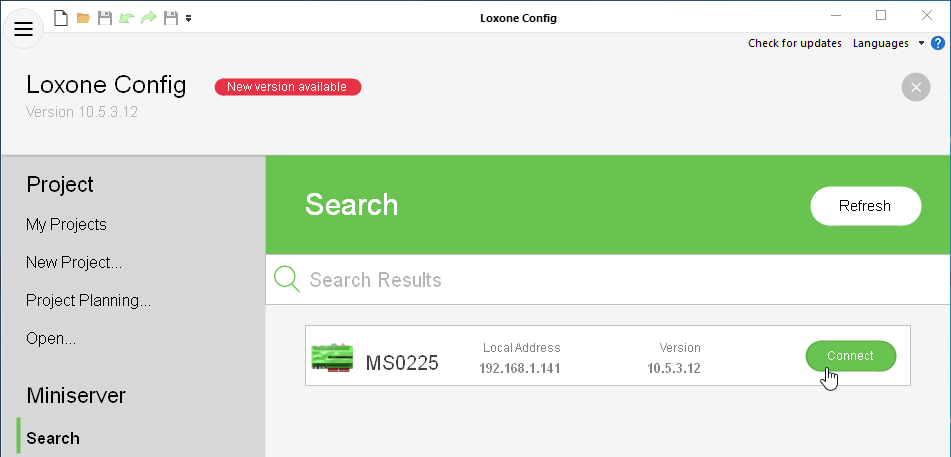
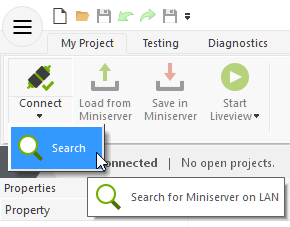
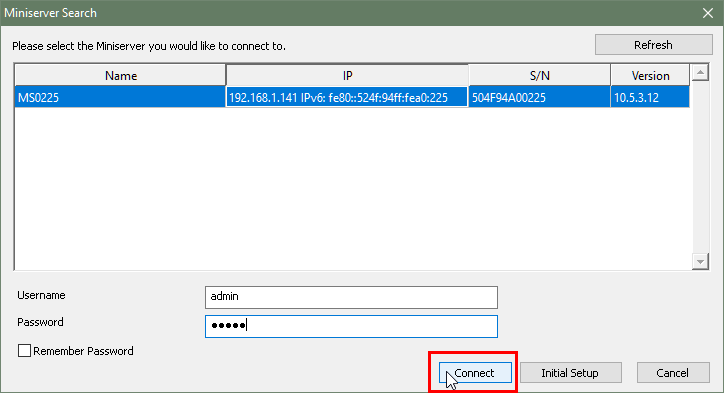
Then follow the instructions for the Initial Setup to create your new project with the Miniserver.
Connecting Extensions↑
Up to 30 extensions can be connected to the Miniserver Go according to the following diagram:
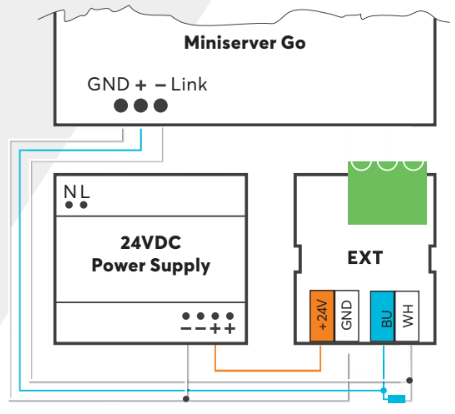
Connect the Extensions to the Miniserver Go by daisy-chaining the Link interfaces. Since the Extensions are connected to a separate power supply, GND must also be connected. This connection is crucial for reliable data transmission.
One twisted pair of a CAT5/6/7 cable can be used to wire the Link throughout a building. We recommend using the blue/white pair.
The Link interface is terminated at the last Extension using the 120 Ohm resistor that is included with the Miniserver.
Pairing Extensions↑
To search for Extensions, first click on a Link Interface in Loxone Config, and then activate Extension Search.
The window that opens will list all connected Extensions that are not yet part of the program to the left:
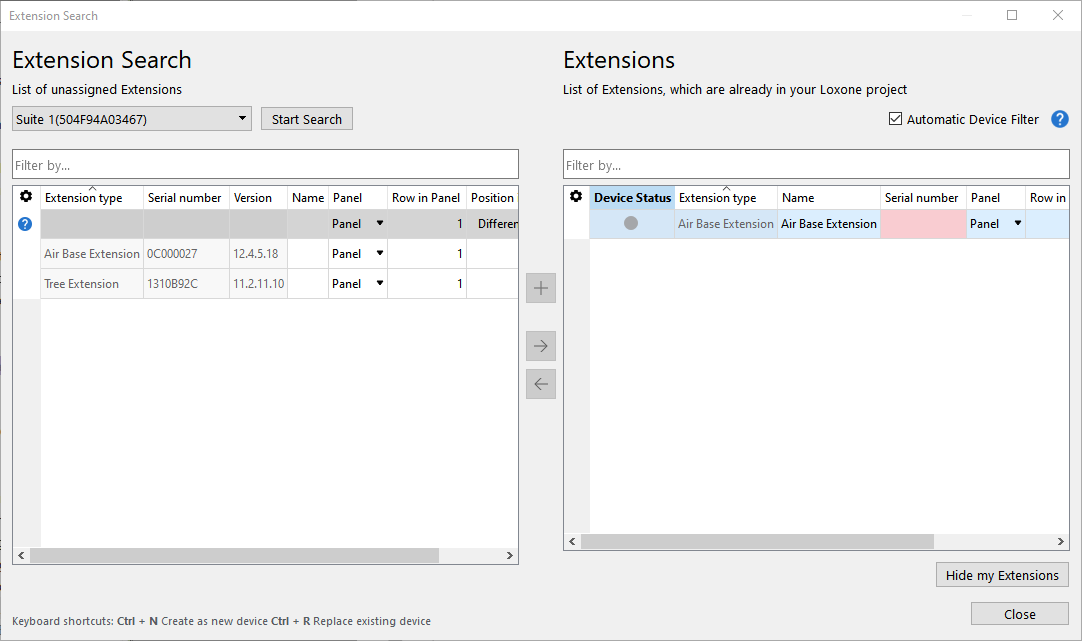
If you select an Extension here, it will identify itself by flashing the status LED. This allows you to assign and name the Extensions correctly.
Select the desired Extension, assign a name and installation location and add it to the programming using the + button.
The right window lists all the Extensions that are currently part of the program. You can display them by clicking the button Show my Extensions. You can also replace an existing Extension with a new one of the same type that was found in the search. This is useful when a device needs to be replaced or devices are added to a pre-configured program. Select the device to be added and the device to be replaced. By clicking on the button with the arrow pointing right, the old device is replaced with the new one in the program.
To apply the changes, save the program in the Miniserver.
Now the added Extensions are ready for use and available in the Periphery Tree in Loxone Config.
Pairing Air Devices↑
Pairing Mode
All Air devices have to be paired in Loxone Config via the pairing mode. In delivery state, pairing mode will be active after the power supply has been established.
On most Air devices, the status LED will indicate this by flashing red/green/orange. You can find the exact pairing mode signal in the documentation of the respective Air device.
On most battery powered Air devices the pairing mode is only active for 5 minutes to conserve energy. Briefly remove the battery and then reinsert it to reactivate pairing mode, if necessary.
If an Air device blinks only orange, then it was previously paired, but can no longer establish a connection. In this case, you have to activate the pairing mode manually. On most devices, this is done by pressing the pairing button or power cycling the device.
Searching and pairing
To search for Air devices, first click on an Air Interface in Loxone Config, and then activate Air Device Search
The window that opens will list all Air devices that are in pairing mode. This can take a few minutes:
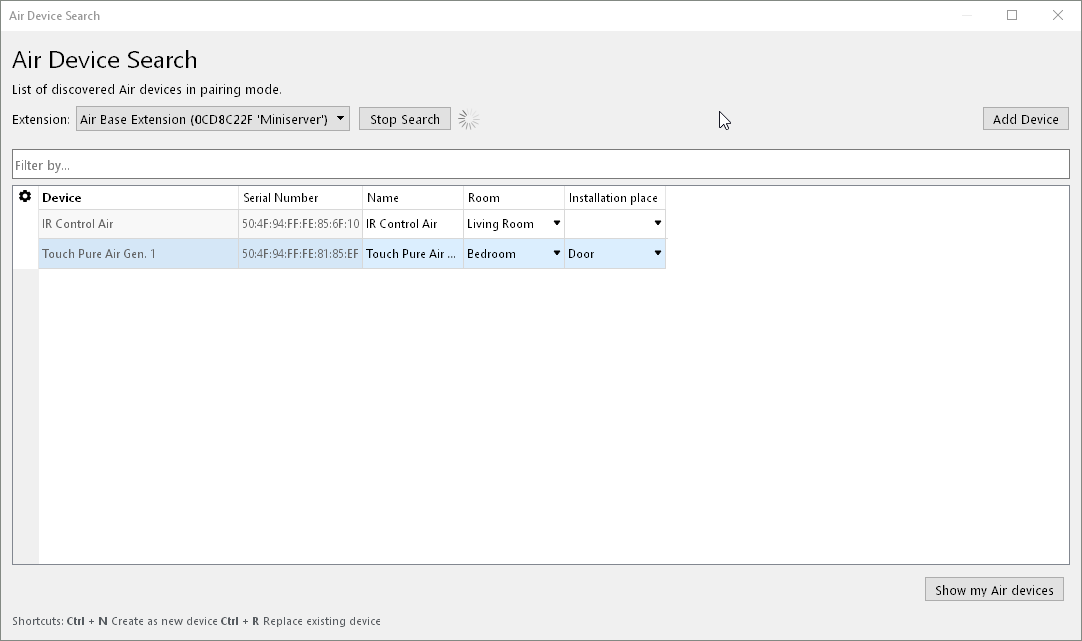
If you select a device here, it will identify itself in different ways. Devices with a status LED will flash it, light fixtures pulse a white light, other devices such as the Loxone Touch emit an audible click. This allows you to assign and name the devices correctly.
Select the desired device, assign a name, room and installation location and add it to the programming using the Pair Device or + button.
The right window lists all the devices that are currently part of the program. You can display them by clicking the button Show my Air devices. You can also replace an existing device with a new device of the same type that was found in the search. This is useful when a device needs to be replaced or devices are added to a pre-configured program. Select the device to be added and the device to be replaced. By clicking on the button with the arrow pointing right, the old device is replaced with the new one in the program.
To apply the changes, save the program in the Miniserver.
Now the added devices are ready for use and the functions are available in the Periphery Tree in Loxone Config.
The Loxone App, under Settings, also supports searching for and pairing Air devices.
Loxone Health Check↑
The diagnostics of the Miniserver and the Loxone interfaces can be started via the Loxone Health Check:

Device Status↑
The Device Status serves as a central overview of the status of all devices in the programming, This enables a fast, but also detailed error diagnosis.
The Device Status can be opened via the menu bar:

If a device is offline, currently being updated or has not yet been paired, this is highlighted in color in the status column:

Diagnostic Options
With a right click on the desired device, individual information can be retrieved and actions triggered. These available options are device-dependent.

1. Text file with details of the selected device
2. Detailed troubleshooting details are summarized in a text file (TechReport), battery powered air devices must be awake for this purpose
3. Reboot device*
4. Get central log file def.log, where important events in the system are logged*
5. Show structure file LoxApp3.json, file to enable communication between user interface and miniserver*
6. Send device command
7. Send device to sleep
8. Keep device awake
* only available for miniserver
Additional information
Update and Diagnostics for Tree Devices
Update and Diagnostics for Air Devices
LED Status↑
| Top LED | Back LED | Description |
|---|---|---|
|
|
|
Everything OK, device is online. |
|
|
|
One or more System Status messages are active. |
|
|
|
Device was selected in Loxone Config and is identifying. |
|
|
|
Update is in progress. |
Boot Phase:
| Top LED | Back LED | Description |
|---|---|---|
|
|
|
Miniserver is booting. |
|
|
|
Miniserver is loading the bootloader image from the SD card. |
|
|
|
Miniserver has successfully loaded the image and will unpack it as the next step. |
|
|
|
Miniserver has successfully unpacked the image. |
|
|
|
Operating system is started. |
|
|
|
SD card cannot be read. Check SD card. |
The LEDs on the RJ45 port are disabled and are off during operation.
Additional information↑
Restore factory defaults and format SD card
Replace Miniserver↑
If a Miniserver needs to be replaced by another one, a wizard is available in Loxone Config to guide you through the necessary steps.
Start the wizard and follow the instructions:

Diagnostic Inputs↑
| Summary | Description | Unit | Value Range |
|---|---|---|---|
| Computing power throttling | Indicates whether the device can be reached by the Miniserver. Diagnostics for Air devices Diagnostics for Tree devices Diagnostics for Extensions |
Digital | 0/1 |
Properties↑
| Summary | Description | Default Value |
|---|---|---|
| Serial Number | Specifies the serial number of the device. For Extensions: Enter 'Auto' to automatically pair an extension with unknown serial number. This can only be used if there is only one Extension of the same type. Save into the Miniserver, in order to pair the Extension. Afterwards the program must be loaded from the Miniserver to transfer the actual serial number of the Extension into the program. |
- |
| Device type | - | |
| Local Address | Enter the local address of the Miniserver, this is the IP address or hostname that can be used to reach it on the local network. Hostnames are not supported in Gateway-Client projects. |
- |
| External Address | Enter the address through which the Miniserver is accessible over the internet (Hostname or IP). If you are using Loxone Cloud DNS, then please enter dns.loxonecloud.com or dns.loxonecloud.com:<port> if you are not using port 80. |
- |
| External Port HTTP | The external port that you specified in the port forwarding settings of your router for the HTTP port of the Miniserver | - |
| External Port HTTPS | The external port that you specified in the port forwarding settings of your router for the HTTPS port of the Miniserver | - |
| Miniserver Configuration | Edit Miniserver settings. A connection to the Miniserver is required. | - |
Safety Instructions↑
Connecting additional Extensions to the Link interface must be carried out by a qualified electrician in accordance with the applicable regulations.
This device must not be used as part of safety-critical systems.











